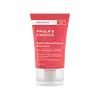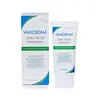What's inside
What's inside
 Key Ingredients
Key Ingredients

 Benefits
Benefits

 Concerns
Concerns

No concerns
 Ingredients Side-by-side
Ingredients Side-by-side

Water
Skin ConditioningGlycerin
HumectantEthylhexyl Palmitate
EmollientHydroxyethyl Acrylate/Sodium Acryloyldimethyl Taurate Copolymer
Emulsion StabilisingIsoamyl Laurate
EmollientPrunus Serotina Fruit Extract
MaskingAlmond/Borage/Linseed/Olive Acids/Glycerides
AntioxidantMedicago Sativa Extract
TonicSesamum Indicum Seed
AbrasiveHydrolyzed Eruca Sativa Leaf
AntioxidantSclerocarya Birrea Seed Oil
HumectantHydrolyzed Algae Extract
Skin ConditioningPalmitoyl Hexapeptide-12
Skin ConditioningPalmitoyl Dipeptide-10
Skin ConditioningSodium Hyaluronate
HumectantCeramide Ng
Skin ConditioningHelianthus Annuus Seed Oil
EmollientCocoyl Proline
Skin ConditioningTocopherol
AntioxidantAllantoin
Skin ConditioningTrehalose
HumectantEclipta Prostrata Extract
Skin ConditioningPotassium Azeloyl Diglycinate
Skin ConditioningOpuntia Ficus-Indica Stem Extract
Skin ConditioningMelia Azadirachta Leaf Extract
Skin ConditioningLeuconostoc/Radish Root Ferment Filtrate
AntimicrobialMoringa Oleifera Seed Oil
EmollientAlaria Esculenta Extract
Skin ProtectingAdenosine Phosphate
Skin ConditioningPEG-10 Phytosterol
EmulsifyingTribehenin
EmollientHydrolyzed Vegetable Protein
Skin ConditioningSorbitan Olivate
EmulsifyingSodium Gluconate
Skin ConditioningZinc Gluconate
Skin ConditioningCopper Gluconate
Skin ConditioningMagnesium Aspartate
Skin ConditioningCetearyl Olivate
Isoamyl Cocoate
Caprylic/Capric Triglyceride
MaskingPolyglyceryl-10 Caprylate/Caprate
EmulsifyingMicrocrystalline Cellulose
AbsorbentC12-15 Alkyl Benzoate
AntimicrobialXanthan Gum
EmulsifyingPentylene Glycol
Skin ConditioningButylene Glycol Stearate
EmollientPhenoxyethanol
PreservativePotassium Sorbate
PreservativeEthylhexylglycerin
Skin ConditioningWater, Glycerin, Ethylhexyl Palmitate, Hydroxyethyl Acrylate/Sodium Acryloyldimethyl Taurate Copolymer, Isoamyl Laurate, Prunus Serotina Fruit Extract, Almond/Borage/Linseed/Olive Acids/Glycerides, Medicago Sativa Extract, Sesamum Indicum Seed, Hydrolyzed Eruca Sativa Leaf, Sclerocarya Birrea Seed Oil, Hydrolyzed Algae Extract, Palmitoyl Hexapeptide-12, Palmitoyl Dipeptide-10, Sodium Hyaluronate, Ceramide Ng, Helianthus Annuus Seed Oil, Cocoyl Proline, Tocopherol, Allantoin, Trehalose, Eclipta Prostrata Extract, Potassium Azeloyl Diglycinate, Opuntia Ficus-Indica Stem Extract, Melia Azadirachta Leaf Extract, Leuconostoc/Radish Root Ferment Filtrate, Moringa Oleifera Seed Oil, Alaria Esculenta Extract, Adenosine Phosphate, PEG-10 Phytosterol, Tribehenin, Hydrolyzed Vegetable Protein, Sorbitan Olivate, Sodium Gluconate, Zinc Gluconate, Copper Gluconate, Magnesium Aspartate, Cetearyl Olivate, Isoamyl Cocoate, Caprylic/Capric Triglyceride, Polyglyceryl-10 Caprylate/Caprate, Microcrystalline Cellulose, C12-15 Alkyl Benzoate, Xanthan Gum, Pentylene Glycol, Butylene Glycol Stearate, Phenoxyethanol, Potassium Sorbate, Ethylhexylglycerin
Water
Skin ConditioningSqualane
EmollientGlycerin
HumectantPentylene Glycol
Skin ConditioningPolyglyceryl-2 Stearate
EmulsifyingGlyceryl Stearate
EmollientStearyl Alcohol
EmollientHyaluronic Acid
HumectantCeramide EOP
Skin ConditioningCeramide Ng
Skin ConditioningCeramide NP
Skin ConditioningCeramide As
Skin ConditioningCeramide AP
Skin ConditioningCarnosine
Skin ConditioningHydrogenated Lecithin
EmulsifyingPhytosterols
Skin ConditioningCaprylyl Glycol
EmollientPolyacrylate Crosspolymer-11
Emulsion Stabilising1,2-Hexanediol
Skin Conditioning
 Reviews
Reviews

Alternatives
Ingredients Explained
These ingredients are found in both products.
Ingredients higher up in an ingredient list are typically present in a larger amount.
Ceramide NG is a type of Ceramide. The NG stands for a sphinganine base.
Ceramides are intercellular lipids naturally found in our skin that bonds dead skin cells together to create a barrier. They are known for their ability to hold water and thus are a great ingredient for dry skin.
Ceramides are an important building block for our skin barrier. A stronger barrier helps the skin look more firm and hydrated. By bolstering the skin ceramides act as a barrier against irritating ingredients. This can help with inflammation as well.
If you would like to eat ceramides, sweet potatoes contain a small amount.
Read more about other common types of ceramides here:
Ceramide AP
Ceramide EOP
Ceramide NP
Glycerin is already naturally found in your skin. It helps moisturize and protect your skin.
A study from 2016 found glycerin to be more effective as a humectant than AHAs and hyaluronic acid.
As a humectant, it helps the skin stay hydrated by pulling moisture to your skin. The low molecular weight of glycerin allows it to pull moisture into the deeper layers of your skin.
Hydrated skin improves your skin barrier; Your skin barrier helps protect against irritants and bacteria.
Glycerin has also been found to have antimicrobial and antiviral properties. Due to these properties, glycerin is often used in wound and burn treatments.
In cosmetics, glycerin is usually derived from plants such as soybean or palm. However, it can also be sourced from animals, such as tallow or animal fat.
This ingredient is organic, colorless, odorless, and non-toxic.
Glycerin is the name for this ingredient in American English. British English uses Glycerol/Glycerine.
Learn more about GlycerinPentylene glycol is typically used within a product to thicken it. It also adds a smooth, soft, and moisturizing feel to the product. It is naturally found in plants such as sugar beets.
The hydrophilic trait of Pentylene Glycol makes it a humectant. As a humectant, Pentylene Glycol helps draw moisture from the air to your skin. This can help keep your skin hydrated.
This property also makes Pentylene Glycol a great texture enhancer. It can also help thicken or stabilize a product.
Pentylene Glycol also acts as a mild preservative and helps to keep a product microbe-free.
Some people may experience mild eye and skin irritation from Pentylene Glycol. We always recommend speaking with a professional about using this ingredient in your routine.
Pentylene Glycol has a low molecular weight and is part of the 1,2-glycol family.
Learn more about Pentylene GlycolWater. It's the most common cosmetic ingredient of all. You'll usually see it at the top of ingredient lists, meaning that it makes up the largest part of the product.
So why is it so popular? Water most often acts as a solvent - this means that it helps dissolve other ingredients into the formulation.
You'll also recognize water as that liquid we all need to stay alive. If you see this, drink a glass of water. Stay hydrated!
Learn more about Water